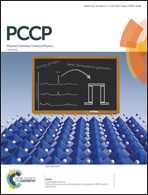Adapting BODIPYs to singlet oxygen production on silica nanoparticles†
Abstract
A modified Stöber method is used to synthesize spherical core–shell silica nanoparticles (NPs) with an external surface functionalized by amino groups and with an average size around 50 nm. Fluorescent dyes and photosensitizers of singlet oxygen were fixed, either separately or conjointly, respectively in the core or in the shell. Rhodamines were encapsulated in the core with relatively high fluorescence quantum yields (Φfl ≥ 0.3), allowing fluorescence tracking of the particles. Various photosensitizers of singlet oxygen (PS) were covalenty coupled to the shell, allowing singlet oxygen production. The stability of NP suspensions strongly deteriorated upon grafting the PS, affecting their apparent singlet oxygen quantum yields. Agglomeration of NPs depends both on the type and on the amount of grafted photosensitizer. New, lab-made, halogenated 4,4-difluoro-4-bora-3a,4a-diaza-s-indacenes (BODIPY) grafted to the NPs achieved higher singlet oxygen quantum yields (ΦΔ ∼ 0.35–0.40) than Rose Bengal (RB) grafted NPs (ΦΔ ∼ 0.10–0.27). Finally, we combined both fluorescence and PS functions in the same NP, namely a rhodamine in the silica core and a BODIPY or RB grafted in the shell, achieving the performance Φfl ∼ 0.10–0.20, ΦΔ ∼ 0.16–0.25 with a single excitation wavelength. Thus, proper choice of the dyes, of their concentrations inside and on the NPs and the grafting method enables fine-tuning of singlet oxygen production and fluorescence emission.



 Please wait while we load your content...
Please wait while we load your content...